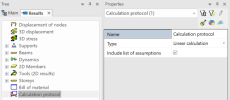Validation of seismic analysis: protocol
Dynamic analysis troubleshooting > seismic analysis > protocol
This section presents points that can be checked after a seismic analysis of a structure. However, as a modal analysis is pre-required for seismic analysis, a validation of the modal analysis should always be performed beforehand.
Check the calculation protocol
After a seismic analysis, the first element to check is the linear calculation protocol.
The linear calculation protocol contains, among other results, a summary table of modal superposition for each seismic load case.

Modes considered for seismic modal superposition
The summary table of each seismic load case lists all modes that are taken into account for modal superposition.
In case mode filtering is enabled, only the selected modes are listed, sorted in decreasing order of the value of modal mass ratio in the direction of the seismic action.
Modal mass ratio
Modal mass ratio values computed in the direction of the seismic action are listed for the considered mode. In the last row is the cumulated modal mass ratio, which can be easily validated against design codes criteria.
Most design codes specify that the cumulated modal mass ratio must be at least 0.90 (90%).
For more details about the required number of modes, see "Validation of modal analysis: specifics for seismic analysis".
Spectral acceleration
The 3 columns Sax, Say and Saz contain the acceleration value from the response spectrum multiplied by the direction factors and by the overall acceleration factor defined in the seismic load case settings.
They can be used to check that the appropriate coefficients have been defined.
Base shear
Base shear values may be used to check the magnitude of the overall seismic action.
The total base shear (last row of the table) may be compared to a simple hand calculation. Please note, that a response spectrum analysis will, in most cases, produce a total base shear value that is smaller than a simplified hand calculation.
In the case of the example shown in the table above:
- Total moving mass (from calculation protocol of eigen frequencies):
- Spectral acceleration at fundamental period:
The spectral acceleration may also be obtained from an approximated fundamental period, e.g. using simplified formulas provided in design codes. - Approximate total seismic force:
The approximate seismic force is lower that the computed value (~15%), but its magnitude is similar.
Overturning moment
The values of overturning moments provided in the summary table are usually not used for validation. They are useful, however, for the verification of the overall stability of the structure.
Next step: check the signature of results

